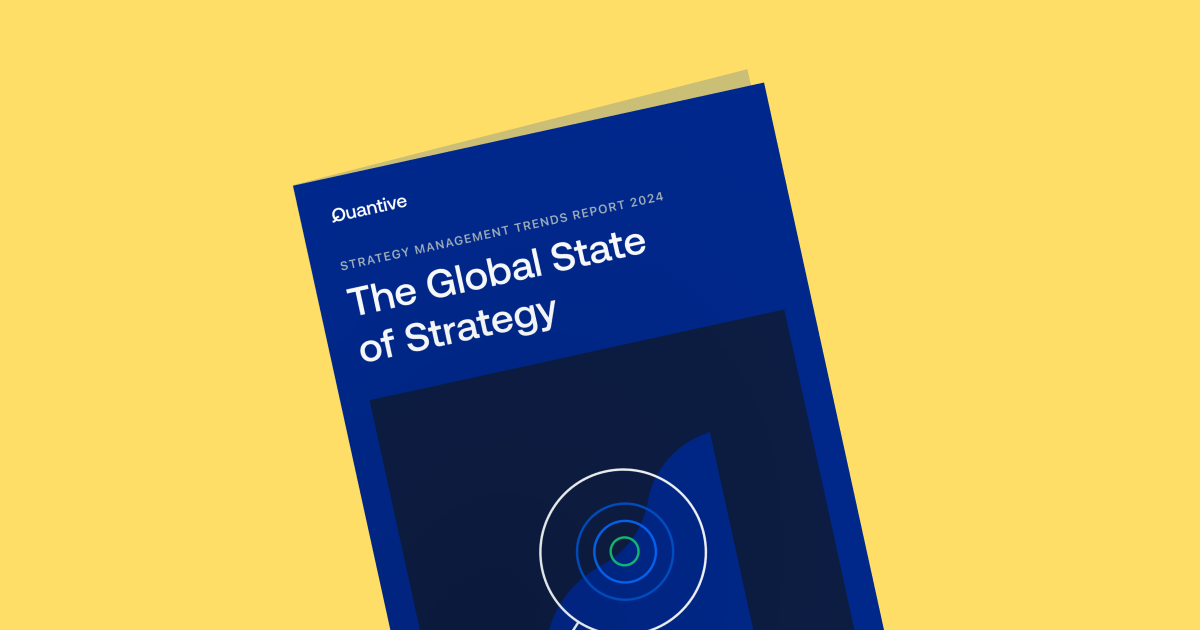A concerning number of enterprises see parts or all of their business strategy fail to realize regularly, leading to major setbacks, missed opportunities, and unrealized potential. According to study findings, “60 to 90% of strategies fail, with fewer than 15% claiming successful implementation.”
This article highlights the six signs that your strategy is failing and proposes a fresh strategic approach to steer your business away from these pitfalls and ensure it realizes its strategic potential.
The six signs of strategy failure include:
- Poor clarity and communication
- Ineffective resource allocation
- Workforce disengagement
- Data blind spots
- Rigidity of the strategy
- Misaligned goals
1. Poor clarity and communication
A lack of clarity and communication is a common sign of a failing strategy — and, unfortunately, is highly prevalent. HBR studies found that 50% of middle managers couldn’t name any of their top five strategic objectives, with less than 5% of employees having a basic understanding of their company’s strategy. This hints at a disconnect between what senior leaders aim to achieve and what’s actually being done, impacting the company’s performance and perception.
Internally, employees may struggle to understand their roles and responsibilities, and how these support the strategic direction. This causes a lack of cohesion — conflicting priorities, misallocated time, distrust in the leadership, and misdirected efforts. Externally, stakeholders may be confused about company’s direction and potential, damaging trust.
2. Ineffective resource allocation
Not using resources in line with your organization’s strategic agenda is a tell-tale sign of strategy failure, preventing your business from reaching its full potential.
Inefficiencies, misused time, and wasted efforts wreak the most havoc on business success. A study found that 76% of employees spend less than three hours a week on strategic work. The negative consequences are exacerbated by the dual role managers and leaders typically take on. Having to juggle operational, manual, and strategic responsibilities limits their bandwidth to contribute to strategic initiatives, resulting in minimal — or downright ineffective — strategic impact.
3. Workforce disengagement
Employee engagement is a potent predictor of strategic success. Without it, a critical link between your workforce and the overarching business strategy is missing.
Workforce disengagement, as a sign of a failing strategy, is often due to a lack of employee awareness about how they support your business’s strategy. If they perceive their contribution to be meaningless, they may view their job as purposeless — a mere laundry list of to-do tasks that exist to be checked off. This, in turn, impacts efficiency as employee engagement can increase productivity by 17% and profitability by 21%.
“Connect the dots between individual roles and the goals of the organization. When people see that connection, they get a lot of energy out of work. They feel the importance, dignity, and meaning in their job.”
– Ken Blanchard
4. Data blind spots
Phoenix Business Journal found that 80% of companies fail to track their goals. Without timely and actionable data, strategic analysis and decision-making becomes a struggle. Data mismanagement — its absence, mishandling, or negligence — forces you to rely on intuition, impulse, or biases during decision-making.
Furthermore, the lack of data-driven strategy execution creates deeper and broader problems for your organization. Without real-time measurement of progress toward strategic objectives, employees are flying blind and will ignoring strategic initiatives until the last minute, when they must rush to make progress.
This impacts progress, with strategy becoming fixed, flawed, or out of sync with evolving circumstances.
5. Rigidity of the strategy
Stagnancy is a glaring indicator of a failing strategy. Marked by a disconnect between your strategy and the market, it’s the result of a lack of adaptability, innovation, and capacity to meet evolving customer needs, ultimately compromising competitiveness. The core issue behind this indicator of this strategy failure is a deficiency in agility — a struggle to anticipate and respond to dynamic market changes.
The strategy could start great, created and communicated effectively. But as time evolves and the business context changes internally and externally, the strategic plan needs to adapt. Unfortunately, confined by the rigidity of planning, review, and management cycles, the strategy becomes gradually disconnected from reality. Unsurprisingly, this impacts financial performance, as an agile transformation significantly increases an organization’s likelihood of being a top-quartile performer, according to McKinsey. It is important to build agility into the strategic planning process from the start.
6. Misaligned goals
Misaligned goals are a common obstacle to strategic success and an evident marker of a failing strategy. According to a 2020 study, only 51% of companies try to establish aligned goals. And among the companies surveyed, only 6% regularly revisit them.
Diverging objectives between departments and teams results in disconnected strategy execution, inefficiencies, and subpar company performance. In this divided landscape, units work separately instead of together, undermining efficient resource use and diluting the success of strategic initiatives. According to The Economist, companies with misaligned strategic objectives report weaker financial results than their more strategically aligned counterparts.
What is the impact of strategy failure in organizations?
Strategy failure in organizations can have profound consequences, affecting multiple business areas, from operational efficiency to overall strategic direction.
Here are some of the main implications of strategic failure.
Setbacks and missed opportunities
When strategies fail, businesses may experience setbacks such as missed deadlines or a failure to capitalize on emerging market opportunities. This can lead to a loss in competitive advantage and limited long-term growth prospects.
Wasted time and energy
Strategy failure may result in employees wasting valuable time and energy on tasks that don't contribute to business goals. This can cause frustration, burnout, and a lack of focus on strategic priorities.
Decreased productivity
Employees who don't understand how their work contributes to the strategy may feel unmotivated. This can cause a lack of direction in their daily tasks, impacting their productivity, drive, and purpose.
Inefficient resource allocation
When resources are misaligned with strategic priorities, businesses waste valuable assets on activities that don't move the needle, limiting growth and goal attainment.
Lack of agility and adaptability
Rigid, inflexible strategies that can't adapt quickly risk falling behind competitors and missing out on new opportunities. This can lead to a loss of market share or complete market displacement.
Disengagement and distrust
When strategies aren't performing as they should, trust and confidence in leadership erodes. This may cause employees and stakeholders to become disillusioned and disengaged, leading to a breakdown in organizational culture, performance, and motivation.
Explore more weaknesses present in traditional approaches to strategy

Overcome strategy failure using Always-On Strategy
The Always-On Strategy model is a transformative solution that addresses the signs of a failing strategy. Designed to counter the challenges posed by traditional strategy management, the Always-On Strategy operates as a continuous, adaptive loop that integrates dynamic strategy development, focused execution, and ongoing evaluation to streamline and optimize business strategy. The goal is to bridge the strategy execution gap, ensuring alignment with market demands while fostering resilience in an ever-changing business landscape.
How the Always-On Strategy addresses signs of strategy failure
The Always-On Strategy model:
- Champions strategy clarity and communication by engaging insights from across the organization throughout the strategy development process, eliminating the disconnect between goals and actions
- Ensures effective resource allocation by creating a strategy with a clear vision and execution plan, resulting in strategically deployed resources that prevent wasteful activities
- Cultivates employee engagement by promoting inclusive decision-making, transparency, and ownership of goals, ensuring employees understand how their contributions drive progress
- Empowers data-driven decision-making by leveraging advanced technology for dynamic data analysis, enabling agile responses in alignment with market changes
- Overcomes strategic rigidity by using adaptive feedback loops for real-time adjustments, addressing challenges, capitalizing on market opportunities, and ensuring competitiveness in dynamic markets
- Aligns goals by collaboratively reassessing and synchronizing these with internal and external demands to minimize conflicting priorities, cultivate cohesive efforts, and drive impactful strategic work
Discover the Always-On Strategy Model

Conclusion
Keeping an eye out for signs of strategy failure can help your business pivot when necessary, averting prolonged setbacks while positioning you for strategic success. Upon recognizing these, you must promptly respond to them as they come.
The Always-On Strategy model operates as a continuous, adaptive loop of strategy management, addressing identified signs of strategy failure head-on. By facilitating strategic clarity, optimal resource allocation, employee engagement, data-driven decisions, agility, and collaborative goal alignment, the Always-On Strategy is a holistic solution for your business strategy, allowing you to navigate the dynamic and unpredictable market to ensure resilience, adaptability, and enduring strategic success.
Quantive empowers modern organizations to turn their ambitions into reality through strategic agility. It's where strategy, teams, and data come together to drive effective decision-making, streamline execution, and maximize performance.
As your company navigates today’s competitive landscape, you need an Always-On Strategy to continuously bridge the gap between current and desired business outcomes. Quantive brings together the technology, expertise, and passion to transform your strategy from a static plan to a feedback-driven engine for growth.
Whether you’re a visionary start-up, a mid-market business looking to conquer, or a large enterprise facing disruption, Quantive keeps you ahead — every step of the way. For more information, visit www.quantive.com.

